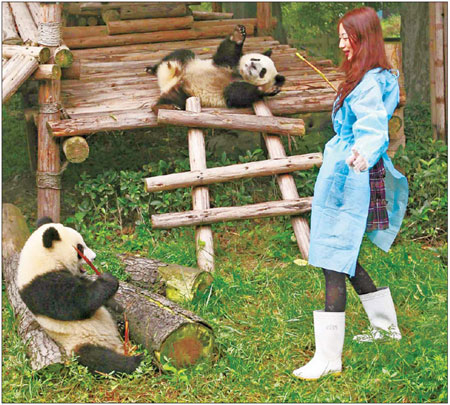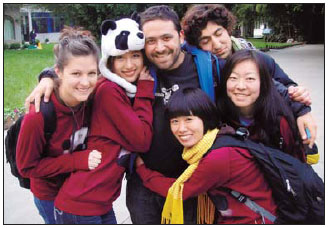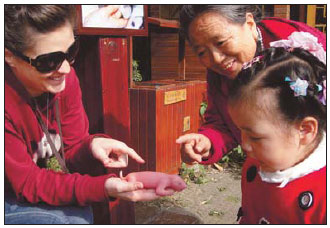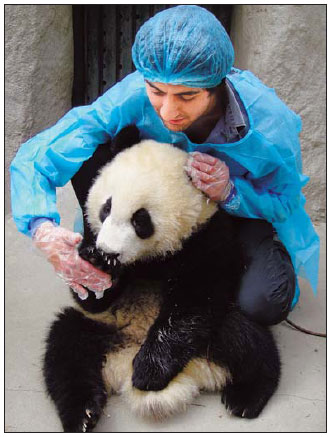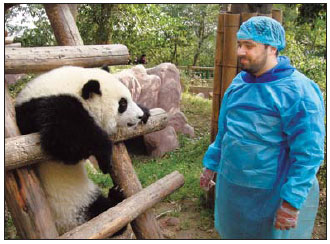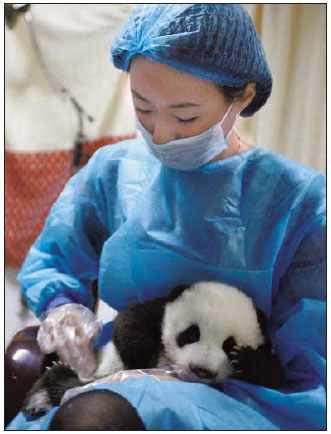Life and Leisure
Care bears
By Matt Hodges (China Daily)
Updated: 2010-11-08 08:14
 |
Large Medium Small |
|
Wang Yu-wen learns all about pandas during a five-week training program in Chengdu, Sichuan province. Xie Minggang / For China Daily |
The protection of giant pandas is a black-and-white issue for the 'pambassadors' who recently graduated from a training program in Chengdu. Matt Hodges reports
Having spent the previous few days tracking wild pandas in a remote Chinese jungle, Florida resident Ashley Robertson returned to the Chengdu Research Base of Giant Panda Breeding to find her cubs all grown up.
Robertson, one of six "pambassadors" who graduated from a five-week training program at the base to promote panda protection on Nov 5, found the cubs she had taken care of were bigger, naughtier and devouring stacks more bamboo.
"I kind of felt what it's like to be a mom," she said. "It was like they had suddenly grown up and I'd missed a step."
Not that the pandas are to be confused with pets. Even though the pambassadors were able to pick them up and play with them, getting a playful bite was a constant peril.
The 25-year-old won an online competition that was launched in August by the base with the support of the World Wide Fund for Nature (WWF) to find six people who could spend October in Southwest China's Sichuan province learning all about the pandas.
"It was kind of like being on a reality TV show," said France's David Algranti, one of two Europeans on the team.
"We had to go through all these stages and qualifiers. It was a bit like American Idol. Then you're in the mud and running through the jungle, and it's like Survivor."
Over 60,000 applicants were whittled down to 12 on the basis of video presentations and an online voting campaign to attract the public to the base's website. After spending a week at the base in late September, the six winners were chosen.
This meant that mainlander Huang Xi, 26; Taiwan model and fledgling TV celebrity Wang Yu-wen, 23; Japan's Yumiko Kajiwara, 35; Sweden's Ali Shakorian, 26; Algranti, 34, and Robertson got to join Hong Kong action stars Jackie Chan and Jet Li, among others, as Chengdu's ambassadors for the giant panda.
Kungfu Panda 2, the sequel to DreamWorks Animation's hugely popular movie, will no doubt help if plans to premiere it in Chengdu next May come to fruition, as suggested by its CEO Jeffrey Katzenberg. The movie includes regional elements such as the Dujiangyan irrigation project, a famous scenic spot, and Chengdu's traditional houses.
The pambassadors' tasks included building panda beds, making the animals exercise through elaborate hunt-for-food games, and cooking panda "mooncakes" to supplement their diet of bamboo and water. They also trained the pandas to accept blood tests without the need for unsafe anesthetic darts.
"I should have known from day one this was going to be an incredible experience," said Robertson, who has been obsessed with pandas since she was a young girl.
The ease with which Robertson and the other pambassadors bantered with Zhang Zhihe, the director of the government-run base, and one of the world's preeminent authorities on giant pandas, showed how China has learned to balance business and pleasure in the realm of ecological conservation.
Zhang said building up the badly depleted stocks of giant pandas in the wild was the program's key goal, but the pandas were also a useful tool for highlighting the need to protect the world's environmental biodiversity.
"Because they're so lovable, giant pandas are a perfect symbol to attract people's attention to the importance of promoting conservation efforts. If we protect them, we protect the other animals and plant species in the area, and we protect ourselves," he said.
One of the pambassadors, Huang Xi, said this project was a good beginning.
"Most people just work hard and care about their jobs. They forget about animals and the environment," said Huang, who makes handicrafts in the factory town of Guangzhou, Guangdong province.
No one knows exactly how many giant pandas remain in the wild, but researchers at the base and statistics by the State Forestry Administration estimate the number at 1,600 worldwide, down from 2,500 in the 1970s. They inhabit mountainous regions in the three neighboring provinces of Sichuan (1,200 pandas), Shaanxi (300) and Gansu (100).
A logging ban in 1998 helped stop the alarming decline in their numbers, but large-scale infrastructure construction and a devastating earthquake in May 2008 have damaged much of their food source and migration routes.
According to WWF, the 8.0-magnitude earthquake that claimed over 87,000 lives, affected 83 percent of the giant pandas' habitat in the region - dubbed "the green heart of China".
It also badly damaged the Longxi Hongkou nature reserve, where the pambassadors spent five days, and destroyed protection systems above 2,000 meters that took 30 years to put in place. Twenty-seven of Sichuan's 40-something giant panda nature reserves were hit.
The majority of the wild pandas live in Sichuan, which sits on one of the world's 25 biodiversity hot spots, the Minshan and Qionglai mountains, home to numerous endangered species, such as the golden monkey, leopard cat, takin and red panda.
The special conditions are a byproduct of the area's wet climate and unusual topography, comprising ranges of mountains near the earthquake-prone Tibetan plateau. The ecological conditions and climate mean the panda's natural habitat has in some areas remained unspoiled for the last 8 million years.
The base has embarked on an ambitious new project called "Panda Valley" that aims to introduce pandas born in captivity into the wild, a feat that has never been successfully carried out before.
The under-construction project, about a two-hour drive from the Chengdu base, will feature three zones that effectively act as buffers between man and the wild, with the pandas rotating between them and acclimatizing to reduced human contact.
Zhang said it will be completed in 2015, and the first pandas relocated there the following year, with a goal of setting them free within 10-20 years.
"We have to be very, very careful," he said. "Many others have tried this and failed."
Robertson, who was privy to a night tour of the facility on Nov 3 that involved access to the infant-panda rearing area, said nothing surprises her anymore about China's wild ambitions.
"I didn't know they had this plan before I came, but now I feel convinced it can succeed, even though it needs a lot of research."
The Chengdu Research Base of Giant Panda Breeding has grown from 10 hectares and six pandas 20 years ago, to 70 hectares and over 100 pandas now.
For the last several years, it has welcomed about half a million tourists a year.
Tour guides at the base say that more than half of the visitors are non-Chinese, many of whom are willing to fork out 1,000 yuan ($150) to be photographed holding a giant panda cub on a wooden bench for one minute.
If Robertson keeps doing her job, hopefully the animals will be around for a lot longer than that.
|
Pambassadors (from left) Ashley Robertson, Wang Yu-wen, David Algranti, Huang Xi, Ali Shakorian and Yumiko Kajiwara. Photos by Matt Hodges / China Daily |
|
American Ashley Robertson shows a child what a panda looks like when it's born. |
|
Sweden's Ali Shakorian has a close encounter with a giant panda. |
|
Frenchman David Algranti is cautious about getting close to a panda because getting a playful bite is a constant peril. |
|
Pambassador Wang Yu-wen, from Taiwan, takes care of a 2-month-old panda. Xie Minggang / For China Daily |
